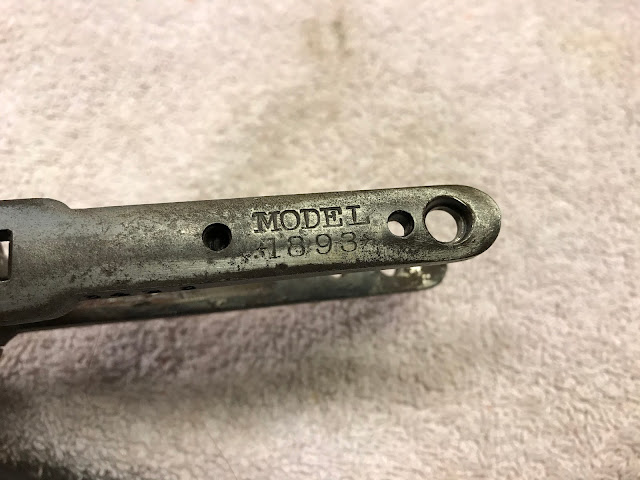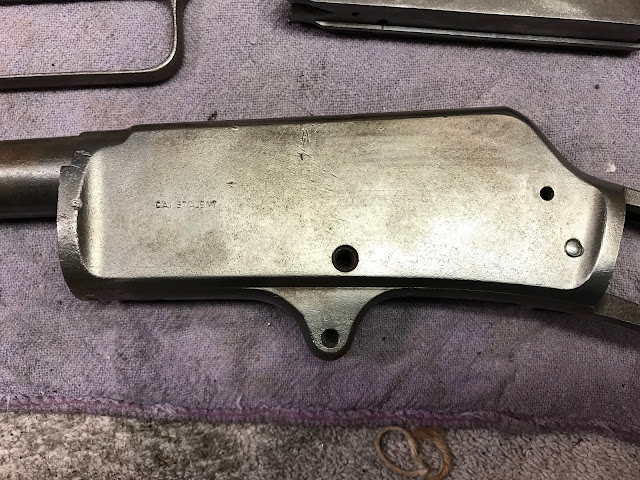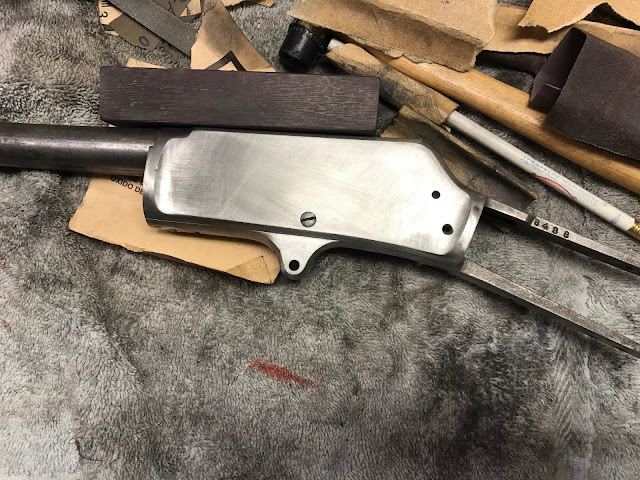Part 5 of this restoration, see the other posts here
Part 1
Part 2
Part 3
Part 4
Before
going headlong into the sanding of the metal I wanted to document the
condition of the roll marks and show you what they are supposed to look
like. The reason for this is to show you that the roll marks were
already nearly gone before we started, so if my sanding obliterates
them, they were already nearly gone.....but not to worry, I think I have
a plan to replace them....
The mfg name and patent dates on the barrel:
I measured the exact location of the roll mark, it sits .079" from the edge of the rear dovetail.
Here is what roll mark should look like:
This roll
mark says "Special Smokeless Steel", alerting the user that this gun was
designed for smokeless powder loads, an important thing to note around
the time this gun was made.
And here is how it should look, it sits on the side of the barrel near the top with the diamond's center lined up with the lower edge of the sight dovetail, just .390" from the rear edge of the cut in.
This roll
mark on top of the receiver is a marketing ploy. Stating that this gun
has a solid top and is "stronger/safer" than the competing guns.
...and this is what it should look like, it sits on top of the receiver, the rear floral is .2" from the edge of the screw hole.
The last one is probably in the best shape of all of them, the model number stamped on the tang
...and what it should look like:
Before getting to the sanding I need to disassemble the bolt....easier said than done, the damn firing pin did not want to come out...after getting it out I discovered why, it had been repaired at one time and was now broken again...another part we'll have to source
I treated the pieces to some naval jelly
Then the wire wheel to remove the scale and let us see how bad the pitting really is
Time to start removing the ugliness....This is the part of restorations I like the least, the beginning...We'll start with the hardest side, the one with the offensive graffiti.
It didn't take too long before the Century stamp started to disappear, but the gouge near the top was more stubborn
The file work complete, time to move to 100 grit Emory cloth
Progress is being made...
You can see the outline in the towel of where the receiver sat.
I attached the lower tang and began sanding the lower side, using 100 grit emory cloth, the progress is slow. You want to make sure you have the parts bolted together when sanding, you want the transition to be imperceptible.
A couple of close ups showing the gouges we have to remove or at least diminish
More progress
A zoomed in close up, showing that the pitting is everywhere on this rifle
Here it is sanded to a 320 grit finish, pretty much all the pits are gone from the sides of the receiver. I am thinking about sand blasting the top, bottom and raised ridges to cover the remaining freckling and give it a modern two-tone look
Now that the metal is close to being ready for final polish, we need to finish fitting the wood
We need to do something about the gaps in the fit
I mixed up some two part epoxy with some of the sawdust I saved from the stocks and applied it to the wood. I taped off and coated the metal parts with carnuba wax
I also filled in the little gap at the toe of the stock, this will help prevent any chipping of the wood if someone is less that gentle when setting down the butt.
In the morning I removed the tape and wood and re fit them, there will be some sanding to be done.
in the next post we will finish fitting the wood to the steel, sand and polish the barrel, then take it to the engraver to see about restoring the roll marks
































